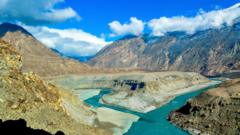A fierce sandstorm has engulfed central and southern Iraq, drastically reducing visibility and leading to a surge in respiratory health issues, sparking concerns among environmentalists about worsening climate conditions.
Severe Sandstorm Hits Iraq, Causes Health Crisis and Transportation Disruptions

Severe Sandstorm Hits Iraq, Causes Health Crisis and Transportation Disruptions
Recent extreme weather event turns skies orange, overwhelms hospitals and raises alarms about climate change impacts in the region.
The severe sandstorm, which struck over the last two days, has left many areas in Iraq bathed in an eerie orange haze. Visibility dropped to less than a half mile in some regions, prompting the suspension of flights at two major airports and rendering the bustling roads of Basra nearly deserted. Reports indicate that thousands were rushed to emergency rooms due to respiratory complications linked to the dust-laden air.
The Iraq meteorology department’s spokesperson, Amir al-Jabri, explained that this storm brewed in eastern Saudi Arabia and was exacerbated by arid conditions in southwestern Iraq. Although sandstorms are a historical characteristic of Iraq’s climate, experts have raised alarms that these events are intensifying due to extended droughts and the increasing desertification of previously arable land.
Witnesses observed a stark contrast to the usually crowded streets, with Basra's highways empty, while police and emergency personnel donned masks to protect against the swirling dust. The storm is reported to be the worst of 2025, following other significant storms in previous years, including one that severely affected Baghdad last December.
Climate change has positioned Iraq as one of the five countries most susceptible to its adverse effects, including soaring temperatures and declining water resources. Following the sandstorm, which brought cooler temperatures but high humidity, hospitals across southern cities reported receiving 3,747 cases linked to breathing issues, with Basra and Najaf registering the highest figures.
As the storm subsides, the aftermath remains: homes and cars are caked with dust, leading many to stay indoors, while local authorities advised families to comfort children disturbed by the storm's intimidating sounds. Environmental experts and officials are urging a deeper examination of the escalating frequency and severity of such weather phenomena in the context of climate change.
The Iraq meteorology department’s spokesperson, Amir al-Jabri, explained that this storm brewed in eastern Saudi Arabia and was exacerbated by arid conditions in southwestern Iraq. Although sandstorms are a historical characteristic of Iraq’s climate, experts have raised alarms that these events are intensifying due to extended droughts and the increasing desertification of previously arable land.
Witnesses observed a stark contrast to the usually crowded streets, with Basra's highways empty, while police and emergency personnel donned masks to protect against the swirling dust. The storm is reported to be the worst of 2025, following other significant storms in previous years, including one that severely affected Baghdad last December.
Climate change has positioned Iraq as one of the five countries most susceptible to its adverse effects, including soaring temperatures and declining water resources. Following the sandstorm, which brought cooler temperatures but high humidity, hospitals across southern cities reported receiving 3,747 cases linked to breathing issues, with Basra and Najaf registering the highest figures.
As the storm subsides, the aftermath remains: homes and cars are caked with dust, leading many to stay indoors, while local authorities advised families to comfort children disturbed by the storm's intimidating sounds. Environmental experts and officials are urging a deeper examination of the escalating frequency and severity of such weather phenomena in the context of climate change.





















